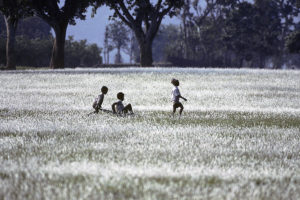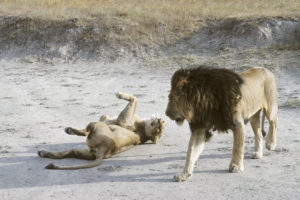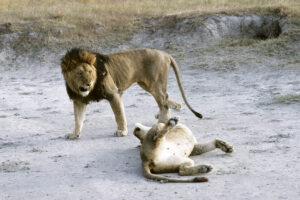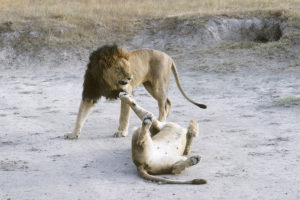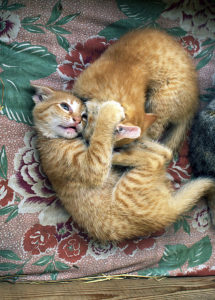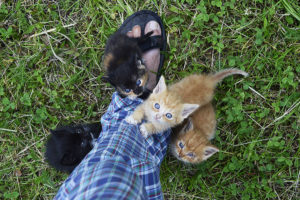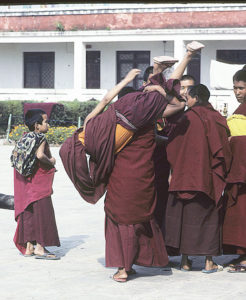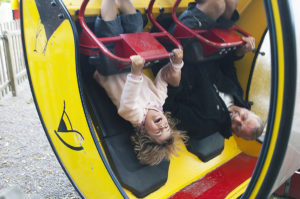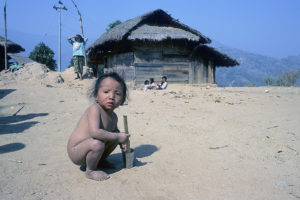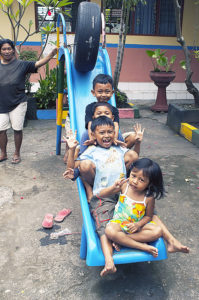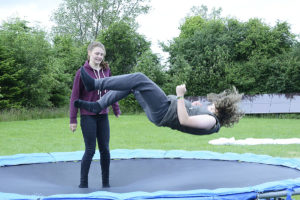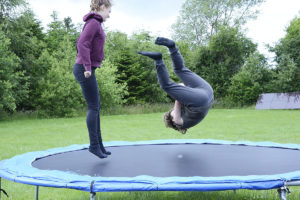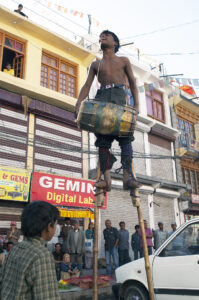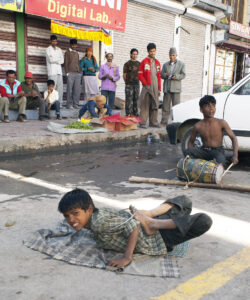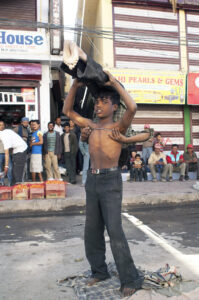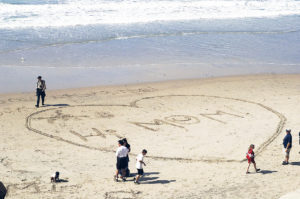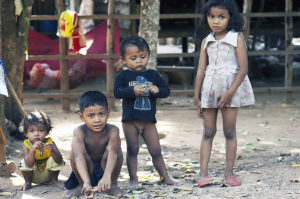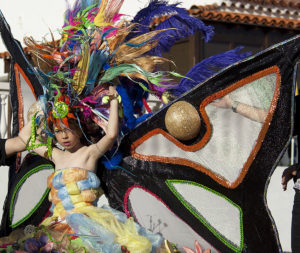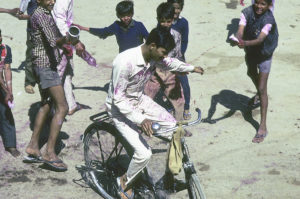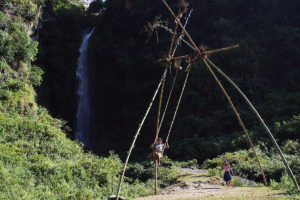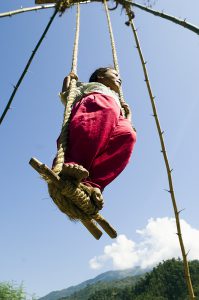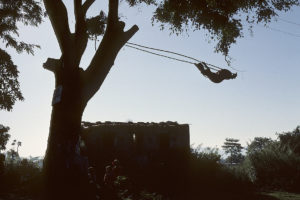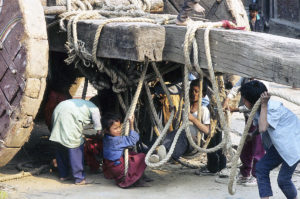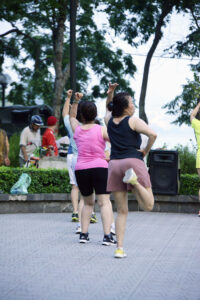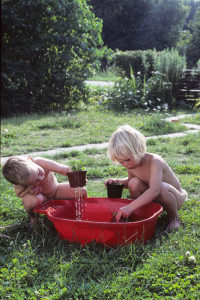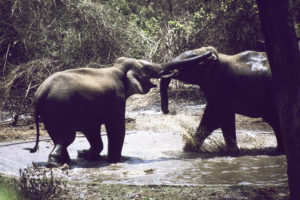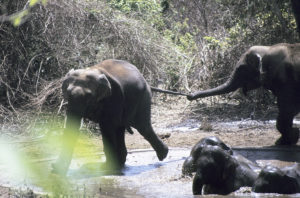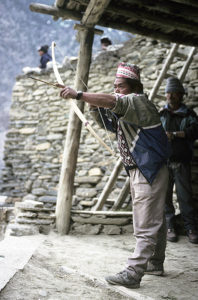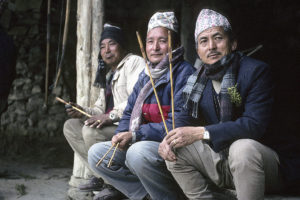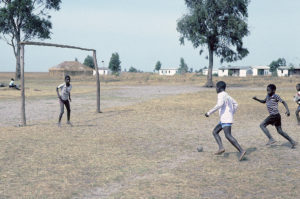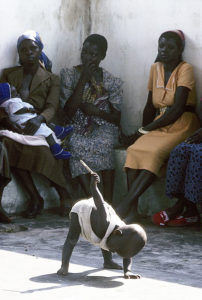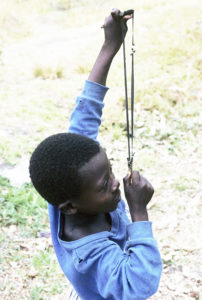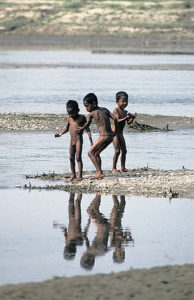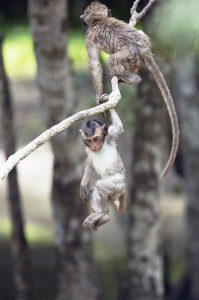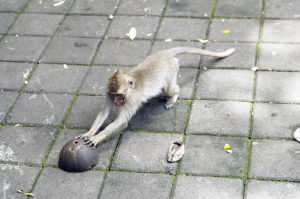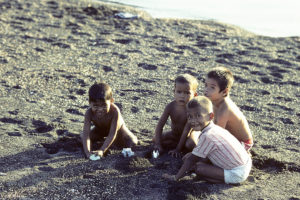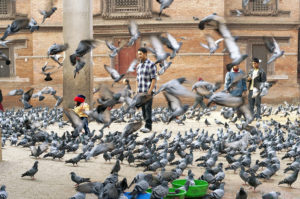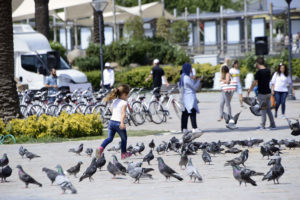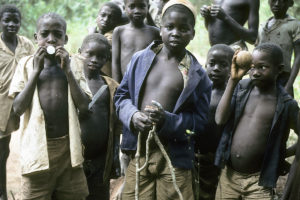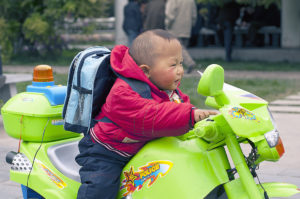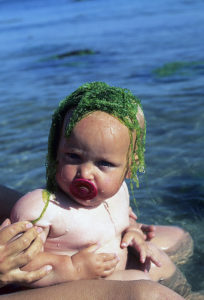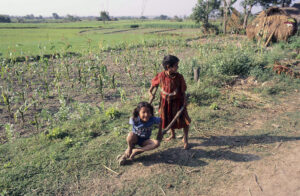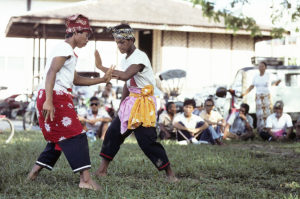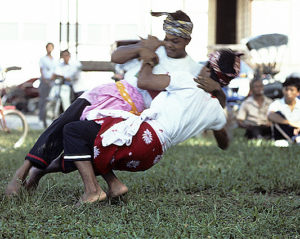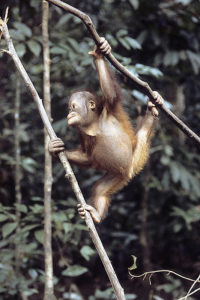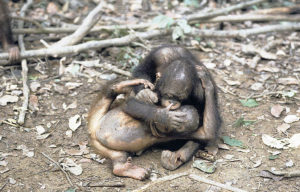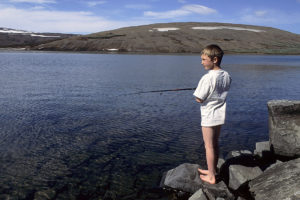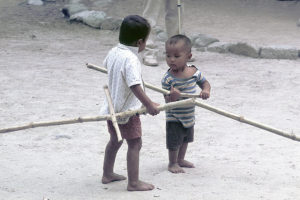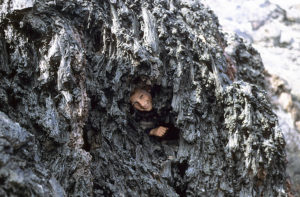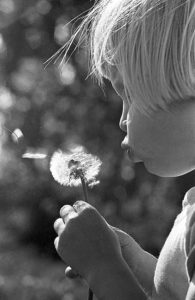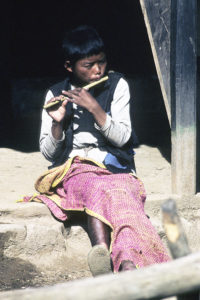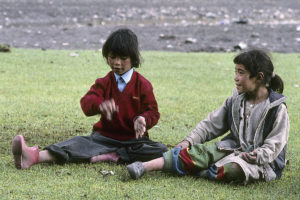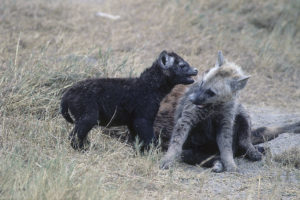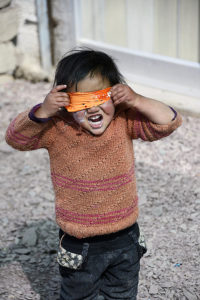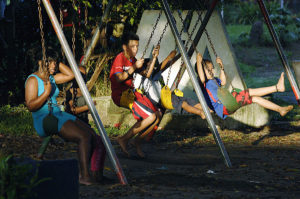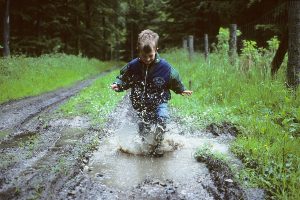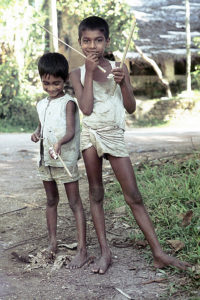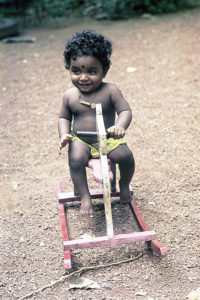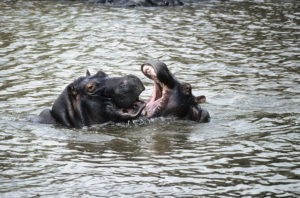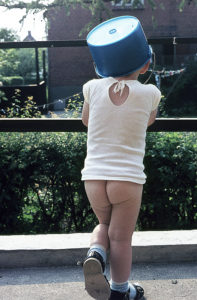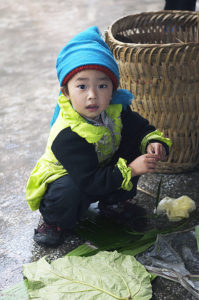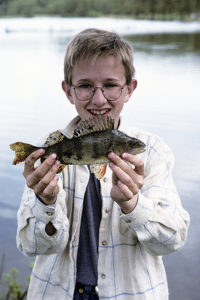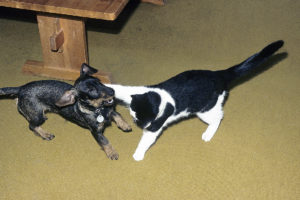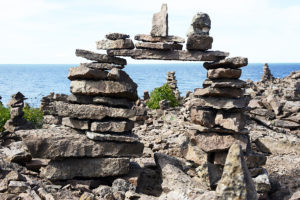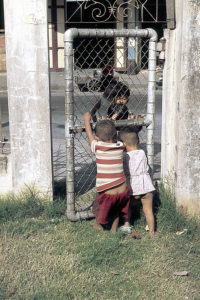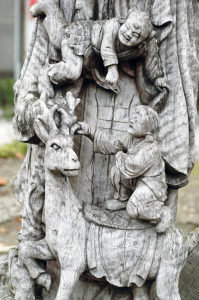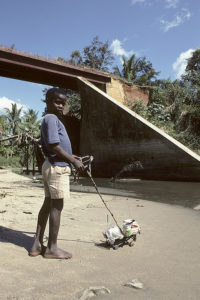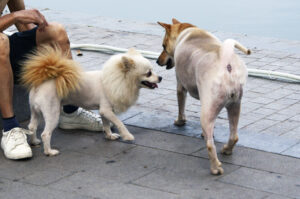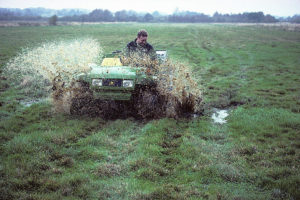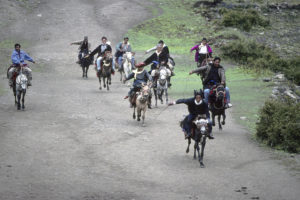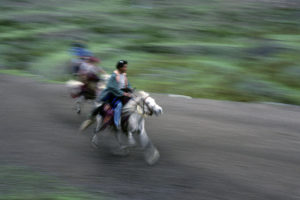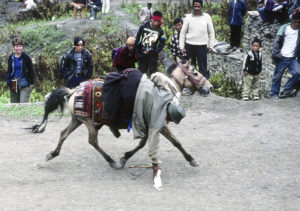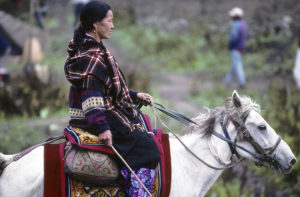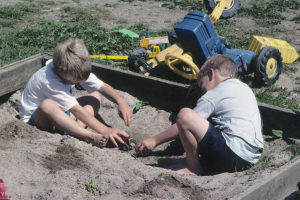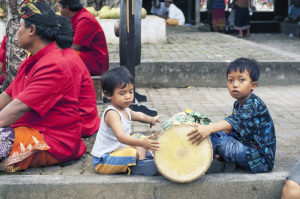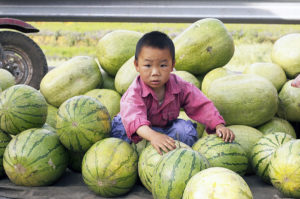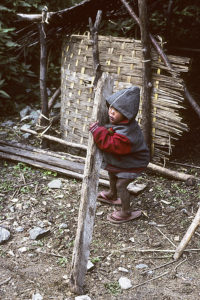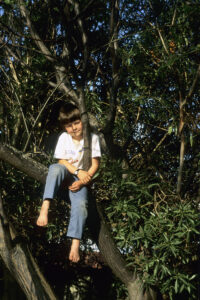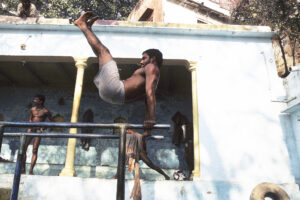Play
On this page, the word play is interpreted in a rather wide sense, also including games, angling, carnivals, archery, etc.
These boys have a great time, playing with a wheelbarrow in a sea of silver-headed grass, Tumlingtar, Arun Valley, eastern Nepal. (Photo copyright © by Kaj Halberg)
The lion (Panthera leo) is described on the page Animals – Mammals: Lion – king of the savanna, and an unusual nightly adventure with lions is related on the page Travel episodes – Tanzania 1990: Lions in the camp.
A playful lioness invites the male to copulate, Ngorongoro Crater, Tanzania. (Photo copyright © by Kaj Halberg)
Kittens are very playful. When playing, they acquire skills, which are necessary later in their life, when they have to start hunting. The taming of the wild cat is described on the page Animals: Animals as servants of Man.
Playful kittens. (Photo copyright © by Kaj Halberg)
Kittens in a hay loft, playing on a discarded sofa. (Photo copyright © by Kaj Halberg)
Playful kitten, biting a vine. (Photo copyright © by Kaj Halberg)
One of these kittens is trying to climb up my trouser leg. (Photo copyright © by Kaj Halberg)
Tibetan Buddhism, or Lamaism, is described in depth on the page Religion: Buddhism.
Tibetan Buddhist monks, playing outside their monastery near Bodhnath, a giant stupa in Kathmandu, Nepal. (Photo copyright © by Kaj Halberg)
A little girl and her father enjoy a merry-go-round, Bornholm, Denmark. (Photo copyright © by Kaj Halberg)
The Gurungs are a Mongolian people, who mainly lives in the Annapurna area, central Nepal. Their main occupation is agriculture, and they also keep domestic animals, including cattle and sheep. Many Gurung men work in the police force or in the army, and quite a few are enrolled in the famous Gurkha regiment, which is often sent to conflict areas around the world. The relatively large salary in this regiment is often invested in the hotel and tourist business.
The main religion of Gurungs is Buddhism, influenced by shamanism. Both beliefs are described on the page Religion.
As their families are often too poor to buy expensive toys, Nepalese children will play with materials at hand. These Gurung children in the Kali Gandaki Valley are building a castle of stones and cardboard wrappings. (Photo copyright © by Kaj Halberg)
During the midday heat, this Gurung child in Ilam, eastern Nepal, is playing with a metal cup and a bamboo stick. (Photo copyright © by Kaj Halberg)
Children in a playground, Ubud, Bali, Indonesia. (Photo copyright © by Kaj Halberg)
Playing on a trampoline, Denmark. (Photos copyright © by Kaj Halberg)
Orphaned boys perform as street entertainers by walking on stilts and, simultaneously, creeping through an incredibly small metal ring, Leh, Ladakh, India. (Photos copyright © by Kaj Halberg)
‘Hi, Mom!’ – Kids have drawn a greeting to their mother on a sandy beach, Torrey Pines State Beach, California. (Photo copyright © by Kaj Halberg)
The Khmer are the most numerous people in Cambodia, accounting for over 97% of the 16 million people in the country. They are descended from the founders of the Khmer Empire (802-1431 A.D.), foremost among Southeast Asian Hindu kingdoms. This empire left a superb legacy in the form of the Angkor ruins.
Khmer children, playing outside their home near Banteay Srey, in the Angkor area. (Photo copyright © by Kaj Halberg)
Posing for group photographs, Hanoi, Vietnam. The girls in the lower picture wear traditional silk dresses, called ao dai. (Photos copyright © by Kaj Halberg)
During a carnival in the town of Los Christianos, Tenerife, Canary Islands, these children have been dressed up for a parade, including a little boy as a clown, and a girl as a giant butterfly.
(Photos copyright © by Kaj Halberg)
Holi is a Hindu spring festival, celebrating the god Krishna, and the victory of good over evil – a gay festival, in which people, regardless of caste, pelt each other with red, yellow, purple, or green powder, or with water, dyed with powder. For this reason, Holi has been dubbed The Festival of Colours.
My ‘colourful’ adventures during Holi are related on the page Travel episodes – India 1991: Attending Hindu festivals in Rajasthan.
During Holi, children spray a passing cyclist with coloured water, Jaisalmer, Rajasthan, India. (Photo copyright © by Kaj Halberg)
During another Hindu festival, Bada Dasain, also called Dassera or Durga Puja, gigantic swings are erected in many Nepalese villages, tied to the end of long ropes, which hang down from the top of four long bamboo poles. Other swings are tied to large branches in trees.
Girls, playing on gigantic swings, hanging down from bamboo poles, central Nepal. (Photos copyright © by Kaj Halberg)
Girl on a swing, which is tied to a branch, Pokhara, Nepal. (Photo copyright © by Kaj Halberg)
Yet another Hindu festival is Bisket Jatra, which is celebrated by the Newar people in the city of Bhaktapur, Kathmandu Valley, Nepal. During this festival, a chariot with an image of the Hindu god Kalo Bhairab (a local form of Shiva), is hauled through the streets.
Children, playing beneath the chariot, which is hauled through the streets of Bhaktapur, carrying an image of the Hindu god Kalo Bhairab. (Photo copyright © by Kaj Halberg)
Morning exercize with techno music, Lake Truc Bach, Hanoi, Vietnam. (Photos copyright © by Kaj Halberg)
Little girls, playing with flower pots in a wash tub, Jutland, Denmark. (Photo copyright © by Kaj Halberg)
The fascinating ancestry of elephants, and the sad fate of these pachyderms, are described in depth on the page Animals – Mammals: Rise and fall of the mighty elephants.
Asian elephants (Elephas maximus), playing in a waterhole, Corbett National Park, Uttarakhand, India. (Photos copyright © by Kaj Halberg)
Thakalis are a people of Tibetan origin, living in an area around the villages Marpha and Tukuche, Upper Kali Gandaki Valley, Annapurna, central Nepal. This people, counting around 15,000 souls, are Buddhists. However, their belief is strongly influenced by shamanism, and many of their festivals stem from the period before the introduction of Buddhism to this area. (Shamanism is described in depth on the page Religion: Animism).
Traditionally, Thakalis are skilful traders, who have for centuries travelled with mule caravans between Tibet and India, trading with cereals, sugar, tea, and industrial goods from India, and salt, wool, and animal hides from Tibet. Agriculture is of less importance in the windblown Upper Kali Gandaki Valley, where monsoon rain is sparse.
Thakalis practice a true form of Communism through the dhigur (a kind of foundation), to which each family contributes the same amount. The money is given to a person in need, who can spend it as he or she pleases, without interference from anybody.
Shamanism is described on the page Religion: Animism.
These Thakali men participate in an archery competition, taking place in the village of Marpha. (Photos copyright © by Kaj Halberg)
The Unga are a Bantu people, who live on islands in the great Bangweulu Swamps, northern Zambia. Their main occupation is fishing, and they also grow manioc, or kassava (Manihot esculenta), besides collecting a number of wild plants, such as rhizomes of water-lilies (Nymphaea) and roots of papyrus (Cyperus papyrus). They also hunt birds and antelope.
The daily life of the Unga people is related in detail on the page Countries and places: Bangweulu – where water meets the sky.
On Ncheta Island in the Bangweulu Swamps, soccer is a very popular game among Unga boys. (Photo copyright © by Kaj Halberg)
During a meeting in a women’s group on Ncheta Island, this child of the Unga tribe is playing with a stick. (Photo copyright © by Kaj Halberg)
Unga boy, hunting birds with a slingshot. (Photo copyright © by Kaj Halberg)
Boys, playing in the Rapti River, southern Nepal. (Photo copyright © by Kaj Halberg)
Of the 23 species of macaque, the long-tailed macaque (Macaca fascicularis) is the most widespread, found from Bangladesh, Myanmar, Laos, and Vietnam, south to the Malaysian and Indonesian Archipelago, and thence east to the Philippines.
This species, and many other monkeys, are described on the page Animals – Mammals: Monkeys and apes.
These two young long-tailed macaques at Angkor Thom, Cambodia, are hanging in a branch, whereupon they let go, dropping into a waterhole. (Photo copyright © by Kaj Halberg)
Young long-tailed macaque, pushing half a coconut shell across flagstones, Wenara Wana Temple (popularly called ‘Monkey Forest’), Ubud, Bali, Indonesia. (Photo copyright © by Kaj Halberg)
Boys, playing on a beach, Lemery, Luzon, Philippines. (Photo copyright © by Kaj Halberg)
City pigeons are a domesticated form of the rock pigeon (Columba livia), which have become feral, often forming huge populations in many cities around the world. Despite the fact that they are often a nuisance, dropping their guano everywhere, and maybe also spreading contagious diseases, feeding them is a very popular occupation.
These birds usually gather in large flocks on city squares, where little children often have fun chasing them. Two examples are shown below.
Durbar Square, Kathmandu, Nepal. (Photo copyright © by Kaj Halberg)
Konak Square, Izmir, Turkey. (Photo copyright © by Kaj Halberg)
Tanzanian boys with balls, made from the sap of a forest vine. They smear a finger in the sap, and when it has dried a little, they blow it up. Then, over the next few hours, they apply several layers of sap, finally producing a small ball. The boy to the right shows a finished ball. (Photo copyright © by Kaj Halberg)
This little boy in in Guiyang, Guizhou Province, China, is playing on a colourful police motorcycle. Note his fancy hairstyle. (Photo copyright © by Kaj Halberg)
Poseidon’s or Neptune’s daughter? – Little girl with green algae on her head, Langeland, Denmark. (Photo copyright © by Kaj Halberg)
Girls, playing wheelbarrow, Sauraha, southern Nepal. (Photo copyright © by Kaj Halberg)
During a stay in Kota Bharu, Malaysia, I witnessed two forms of local games, shown in the pictures below.
Gasing is a spinning top, weighing around 5 kilos. A rope is tied around the top, and with the help of this rope, the top is hurled onto a flat piece of ground. While the top is spinning, another man shovels up the top with a bat, placing it on a narrow piece of metal, which again has to be placed on a piece of wood. The top must not be touched with your hands. The team, whose top is spinning for the longest time, has won.
Silat is a stylized martial art, somewhat resembling dancing. The point is to fool the opponent and then suddenly throw him to the ground.
Gasing, Kota Bharu. (Photo copyright © by Kaj Halberg)
Silat, Kota Bharu. (Photos copyright © by Kaj Halberg)
Orangutans (Pongo) are closely related to humans – a fact which is also seen in their name, from the Malay orang (’Man’), and utan (’forest’), thus ‘Forest Man’. During the last hundred years or so, orangutans have declined drastically and are now in danger of extinction. The main reason for this decline is habitat destruction, as huge areas of rainforest have been cleared by the timber industry and converted into oil palm plantations and farmland. Another reason is that poachers shoot female orangutans to get hold of their young, which are sold to zoos or others.
In Borneo, a number of rehabilitation centres for orangutans have been established, where orphaned young Bornean orangutans (Pongo pygmaeus), which have been confiscated from poachers, are trained to live in the forest, after which they are released into safe areas, such as national parks.
These fascinating animals are described in depth on the pages Animals – Mammals: Monkeys and apes, and Travel episodes – Borneo 1985: Visiting orangutans.
Orphaned orangutans, Sepilok Orangutan Rehabilitation Centre, Sabah, Borneo. (Photos copyright © by Kaj Halberg)
Boy, angling for trout, Lake Isholsvatn, northern Iceland. (Photo copyright © by Kaj Halberg)
The Batak are a group of closely realated Austronesian peoples, including the Karo, Pakpak, Simalungun, Toba, Angkola, and Mandailing, who live in a large area of northern Sumatra, Indonesia. My acquaintance with these people stems from a visit to Lake Toba in 1975.
Other pictures, depicting the Batak and their culture, are shown on the pages Culture: Musicians, and Culture: Folk art around the world.
These Batak children have fun, riding on water buffaloes, which they bring home after work in the paddy fields, Samosir Island, Lake Toba. (Photo copyright © by Kaj Halberg)
Batak children, playing with bamboo stems, Samosir Island. (Photo copyright © by Kaj Halberg)
Morning exercize, Hanoi, Vietnam. (Photo copyright © by Kaj Halberg)
This boy is peeping through a hole in hardened lava, stemming from an eruption of the volcano Krafla, near Lake Myvatn, Iceland, which took place about 15 years earlier. (Photo copyright © by Kaj Halberg)
The widespread dandelion (Taraxacum officinale) is described on the page Plants: Plants in folklore and poetry.
This little Danish boy has fun, blowing seeds off a dandelion. (Photo copyright © by Kaj Halberg)
This boy in the town of Basantapur, eastern Nepal, is enjoying himself, playing on a simple flute, made from a thin bamboo stem. (Photo copyright © by Kaj Halberg)
When snow covers the ground, Danish children bring out their sledges and skies to glide down hills. (Photo copyright © by Kaj Halberg)
Playing with a feather ball, Hanoi, Vietnam. (Photos copyright © by Kaj Halberg)
These girls in the Markha Valley, Ladakh, India, play an ancient game. They throw several pebbles into the air, grabbing as many pebbles as possible from the ground, before catching the falling ones. (Photo copyright © by Kaj Halberg)
The spotted hyaena (Crocuta crocuta) is found in most of sub-Saharan Africa, with the exception of deserts, rainforests, and alpine areas on mountain tops. This species once ranged all over Europe and northern Asia, from Spain and France east to eastern Siberia. It is still not clear why it went extinct in Siberia, but its disappearance from Europe is linked to the decline in grasslands – its favoured habitat – about 12,500 years ago.
The spotted hyaena has a very complex social behaviour, with respect to group-size, hierarchical structure, and frequency of social interaction among both kin and unrelated group-mates. However, their social system is openly competitive rather than cooperative, with access to kills, mating opportunities, and the time of dispersal for males, all depending on the ability to dominate other clan-members. (Source: Holekamp, Sakai & Lundrigan, 2007. Social intelligence in the spotted hyena (Crocuta crocuta). Philosophical Transactions of the Royal Society, London, 362, pp. 523-538)
A very young pup of spotted hyaena, playing with an older pup outside their den, Ngorongoro Crater, Tanzania. When the pups are born, they are jetblack. With age, they become pale grey, before changing into the brownish pelt of adults. (Photo copyright © by Kaj Halberg)
Little girl, playing with a punctured balloon, Lahaul, Himachal Pradesh, India. (Photo copyright © by Kaj Halberg)
Children on swings in evening light, Tortuguero, Limón, Costa Rica. (Photo copyright © by Kaj Halberg)
This little boy has fun, splashing in a puddle after heavy rain, Jutland, Denmark. (Photo copyright © by Kaj Halberg)
The Sinhalese are a people from North India, who, in the 6th Century B.C., conquered most of Sri Lanka and created an advanced civilization with several competing kingdoms. The various peoples of Sri Lanka are described on the page Travel episodes – Sri Lanka 1974: Among the Veddas.
Sinhalese boys, playing with ‘air guns’, made from thin sticks, which fit into a tube. When you press the stick into the tube very quickly, you are able to shoot pebbles quite a distance. (Photo copyright © by Kaj Halberg)
Little Sinhalese girl on a rocking horse, Horana. (Photo copyright © by Kaj Halberg)
The hippo (Hippopotamus amphibius) is described on the page Animals – Mammals: Hippo – the river horse that lives on both sides.
Hippos, playing in the Banagi River, Serengeti National Park, Tanzania. (Photo copyright © by Kaj Halberg)
Little boy, playing with a bucket, Jutland, Denmark. (Photo copyright © by Kaj Halberg)
The Yi people, also known as Nuosuo or Lolo, are an ethnic group, living in China, Vietnam, and Thailand. Numbering around 9 million people, they are among the largest of the 55 ethnic minority groups, which are officially recognized by the People’s Republic of China. (Source: en.wikipedia.org/wiki/Yi_people)
Other pictures, depicting Chinese tribal peoples, are shown on the page People: Chinese minorities.
This little Yi girl is playing with bits of banana leaves, which her parents have been using to wrap around goods, to be sold at a market in the town of Yuanyang, Yunnan Province, China. (Photo copyright © by Kaj Halberg)
This boy proudly presents his catch, a perch (Perca fluviatilis), Jutland, Denmark. (Photo copyright © by Kaj Halberg)
Usually, dogs and cats are sworn enemies, but if they grow up together, like this cat and wire-haired dachshund, they can be the best of friends. (Photo copyright © by Kaj Halberg)
Little boy, playing in a basket, Kathmandu, Nepal. (Photo copyright © by Kaj Halberg)
This old stone quarry near Djupvik, Öland, Sweden, has been converted into a playground, in which people build ‘sculptures’. (Photo copyright © by Kaj Halberg)
Little children, playing with a gate, Bangkok, Thailand. The girl wears no trousers at all, and soon the boy will drop his. (Photo copyright © by Kaj Halberg)
This old and weathered wooden sculpture in Taichung, Taiwan, depicts children, playing with a deer. More pictures of wood carvings from Taiwan and other places may be seen on the page Culture: Wood carvings. (Photo copyright © by Kaj Halberg)
The Makonde are a Bantu people, who originated from the Mueda Plateau in northern Mozambique. They managed to avoid being victims of the Muslim slave trade in East Africa, and only came under colonial rule in the 1920s. In the 1960s, the Portuguese were expelled from Mozambique, and the revolution was primarily financed by the sale of the famous Makonde wood carvings.
Today, Makonde people live throughout Mozambique and Tanzania, besides a small number in Kenya.
Makonde boy, playing with a home-made toy car, Kitere, southern Tanzania. (Photo copyright © by Kaj Halberg)
This mural in Povls Church, Bornholm, Denmark, depicts serious sins – at least according to certain puritanical Christian sects – such as playing music, dancing, and playing games. Christianity is described in depth on the page Religion: Christianity. (Photo copyright © by Kaj Halberg)
The complicated ancestry of the domestic dog is described on the page Animals: Animals as servants of Man.
Playing dogs, Hanoi, Vietnam. (Photo copyright © by Kaj Halberg)
Playing pups, Gyantse, Tibet. (Photo copyright © by Kaj Halberg)
The red-billed chough (Pyrrhocorax pyrrhocorax) and its close relative, the yellow-billed, or alpine chough (P. graculus), are jet-black birds of the crow family (Corvidae). You often observe them in large flocks, swooping and diving, while calling incessantly – obviously showing sheer pleasure of flying.
Both species are described in depth on the page Animals – Birds: Corvids.
Yellow-billed choughs, soaring over the Ghunsa Valley, eastern Nepal. (Photo copyright © by Kaj Halberg)
Boys, playing in a flooded street, Delhi, India. The taxi in the background is in trouble. (Photo copyright © by Kaj Halberg)
This young man has fun with an off-roader in a wet meadow, Jutland, Denmark. (Photo copyright © by Kaj Halberg)
During the annual Tibetan Yartung Festival, held in the Jhong River Valley, Mustang, central Nepal, a lot of festivities take place, including a horse race. The aim is to be the one that picks up a white scarf, a khata, placed on the ground. A few women also participate in this race.
(Photos copyright © by Kaj Halberg)
Boys, playing in a sandpit, Denmark. (Photo copyright © by Kaj Halberg)
During a Hindu temple festival, taking place in Ubud, Bali, Indonesia, these small boys are playing with a drum. (Photo copyright © by Kaj Halberg)
This boy is playing among watermelons, which his parents are selling at the roadside, Yunnan Province, China. (Photo copyright © by Kaj Halberg)
Wearing his mother’s slippers, this little boy is trying to move a plank, the size of which is obviously beyond his abilities, Bagarchap, Marsyangdi Valley, central Nepal. (Photo copyright © by Kaj Halberg)
Boy, climbing a tree, Cape Town, South Africa. (Photo copyright © by Kaj Halberg)
Morning exercize, Varanasi, Uttar Pradesh, India. (Photo copyright © by Kaj Halberg)
(Uploaded October 2016)
(Latest update February 2024)
